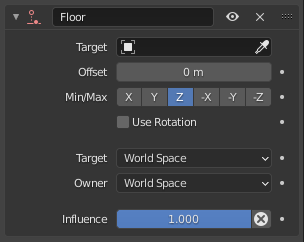Piso¶
A restrição do tipo «Piso» permite que você utilize a posição de seu alvo (e uma rotação opcional) para especificar um plano com uma espécie de «lado proibido», onde o proprietário não poderá ir. Este plano pode ter qualquer orientação que você deseje. Em outras palavas, ele cria um piso (ou um teto, ou uma parede…) Note que ele somente é capaz de simular planos inteiramente lisos, mesmo que você utilize a opção Grupo de vértices. Ele não pode ser usado para pisos ou paredes irregulares.
Opções¶

Painel da restrição tipo «Piso».¶
- Target
Identificador de dados used to select the constraints target, and is not functional (red state) when it has none. See common constraint properties for more information.
- Deslocamento
Allows you to offset the «floor» plane from the target’s origin, by the given number of units. Use it e.g. to account for the distance from a foot bone to the surface of the foot’s mesh.
- Mínimo e Máximo
Controls which plane will be the «floor». The names of the buttons correspond, indeed, to the normal to this plane (e.g. enabling Z means «XY plane», etc.). By default, these normals are aligned with the global axes. However, if you enable Use Rotation (see above), they will be aligned with the local target’s axes. As the constraint does not only define an uncrossable plane, but also a side of it which is forbidden to the owner, you can choose which side by enabling either the positive or negative normal axis… e.g. by default Z, the owner is stuck in the positive Z coordinates.
- Usar rotações
Forces the constraint to take the target’s rotation into account. This allows you to have a «floor» plane of any orientation you like, not just the global XY, XZ and YZ ones…
- Target/Owner
Standard conversion between spaces. See common constraint properties for more information.
- Influência
Controls the percentage of affect the constraint has on the object. See common constraint properties for more information.